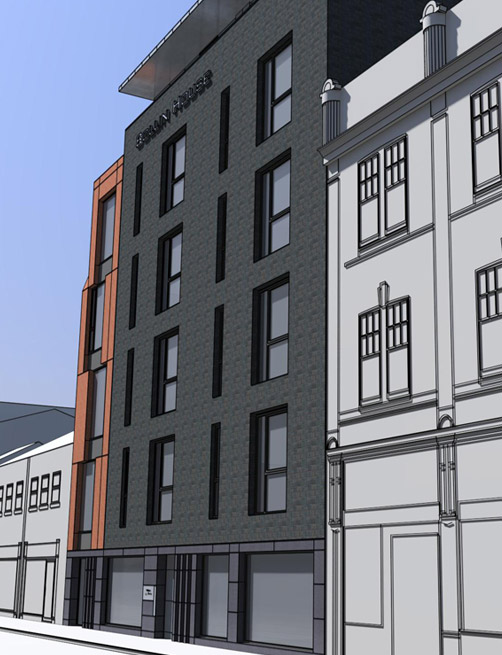Bollin House is a new mixed use building comprising ground level active retail/leisure use with 14 apartments on the upper five floors.
The site is knitted into the close urban grain of this part of the city's Northern Quarter and sits within the Smithfield Conservation area.
The proposal to demolish in a Conservation Area followed a rigorous and extensive design analysis of the existing buildings on the site. A robust design exploration determined that demolition and reconstruction was the only viable option for development of the site. Reid put together a full justification for the demolition and designed a replacement building that was seen by the planning authority as providing the necessary preservation and enhancement of the qualities of the Conservation Area.
The elevational concept is derived from the mass, form and material of the contextual buildings and street patterns. The solid to void relationships of the plan generate the elevational composition and articulation with the material selection of stone, brick and corten steel pick up on clues of the warehousing history of the site.
More contemporary forms such as the floating roof are a valid overlay to reflect that this area now gives a home to many of the city's vital smaller creative industries. Increasing the numbers living locally will serve to strengthen the growing community here.
The site is knitted into the close urban grain of this part of the city's Northern Quarter and sits within the Smithfield Conservation area.
The proposal to demolish in a Conservation Area followed a rigorous and extensive design analysis of the existing buildings on the site. A robust design exploration determined that demolition and reconstruction was the only viable option for development of the site. Reid put together a full justification for the demolition and designed a replacement building that was seen by the planning authority as providing the necessary preservation and enhancement of the qualities of the Conservation Area.
The elevational concept is derived from the mass, form and material of the contextual buildings and street patterns. The solid to void relationships of the plan generate the elevational composition and articulation with the material selection of stone, brick and corten steel pick up on clues of the warehousing history of the site.
More contemporary forms such as the floating roof are a valid overlay to reflect that this area now gives a home to many of the city's vital smaller creative industries. Increasing the numbers living locally will serve to strengthen the growing community here.

